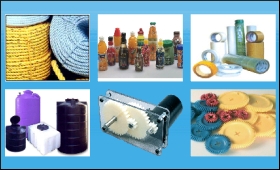|

|
The planet's pernicious plastic plague peril
|
|

|
|
| Top Stories |
 |
|
|
|
Dr Bradnee Chambers | 04 Jun, 2018
Thanks to the wonders of modern industrial technology we are now
producing 20 times as much plastic as we were doing in 1964. If the
current trend continues, output will double in 20 years and double again
by 2050.
Our hunger for the convenience of plastic products is
insatiable. Buy it, use it, throw it away, buy another one -- drinks
come in plastic bottles with plastic drinking straws; food comes wrapped
in cling film; fast food is served in polystyrene containers with
plastic cutlery. No need to wash up; just throw it away. Sorted. If only
that were true.
Modern society has become addicted to plastic
and it is high time that we started to wean ourselves off. A start would
be to devise proper schemes to manage plastic -- alternatives to
burying it, burning it or dumping it in rivers to be carried out to sea.
The patch of accumulated plastic floating around the Pacific gyre now
dwarfs the area of countries as large as Myanmar or France. And every
minute the equivalent of a lorry-load of plastic is added to the mess.
Even the Arctic is not immune with plastic being found in record
quantities there too.
All of the plastic that ends up in our
oceans originates from land; nine-tenths of it is carried into the sea
along 10 rivers -- eight of them are in Asia, including the Ganges, the
Yangtze, the Yellow, the Pearl and the Mekong.
Plastic debris is
unsightly and the authorities of seaside resorts organise clean-ups to
make sure that the beaches are in a fit state for tourists. But as well
as being offensive to the eye, plastic waste is posing a serious threat
to our already embattled wildlife.
Six pack yokes -- the six
connected plastic rings used to hold beer cans together -- drinking
straws, cotton buds, shopping bags, plastic fishing nets all pose a
danger to animals that either become entangled in them, are impaled by
them or eat them -- turtles in particular eat plastic bags because they
resemble jellyfish which are their normal prey.
Recently, a
Cuvier's Beaked Whale found off Norway was discovered to have 30 plastic
bags in its stomach. A Sperm Whale washed ashore in Spain had 64 pounds
(29 kilos) of plastic inside it. Albatrosses also feed their chicks
with bottle tops, again mistaking the colourful morsels for food --
leading to a slow and painful death for the young birds, whose
intestines become blocked.
This is all very sad for the
individual animals affected and potentially disastrous for rare species,
already battling with habitat loss, prey depletion, over-exploitation
and a series of other, mainly man-made, threats. But as plastics enter
the food chain, there are likely to be direct effects for people too,
because the planet's premier predators are humans. Eventually, the
plastic from the discarded wrapper may end up in the fish on our dinner
plate.
CMS, the UN body charged with ensuring the survival of the
world's endangered migratory animals, has long taken the threat of
plastic pollution seriously. We were pleased to offer a platform to the
innovative and enterprising young Dutchman, Boyan Slat, at our
conference in Quito in 2014, to expound his ideas for cleaning up our
seas.
Just last year at our conference in Manila, the
representatives of our 120-plus member-countries adopted a set of
measures on the management of marine debris, highlighting the dangers of
ingesting and entanglement in plastic and the possible role of
microplastics as vehicles for spreading toxins and pathogens. The
Resolution recognises that dedicated bodies such as UN Environment, the
International Maritime Organisation, the UN Regional Seas Programmes,
the Food and Agriculture Organisation, among others, are on the case. It
also recognises the importance of education campaigns and enlisting the
support of industry and the general public alike, to change perceptions
and gain acceptance of the need to phase out single-use plastics and
introduce effective recycling programmes.
Some countries are
acting: Kenya has introduced a total ban on plastic bags, while in the
UK the leading supermarket chains have made a pledge to reduce plastic
packaging. And just last month, the European Union announced that it was
joining the fray by prohibiting a range of plastic products for which
greener alternatives exist.
India is the Host Country for this
year's World Environment Day with its theme of "Beat Plastic Pollution".
There has been good news from India, where, for example, after an
intensive clean-up campaign undertaken by local activists, the first
female Olive Ridley marine turtle in 20 years nested at Versova Beach,
Mumbai. This is exactly the sort of development that we want to hear
about with India hosting the next CMS conference in 2020.
The
record-breaking sailor, Dame Ellen MacArthur, has predicted that by 2050
there will be more plastic in the oceans than fish. My heartfelt plea
is that governments, industry and consumers do all they can to make sure
that that nightmare scenario does not become reality.
|
|
|
| |
|
|
|
|
|
|
|
|
|
|
|
|
|
|
| |
| Customs Exchange Rates |
| Currency |
Import |
Export |
US Dollar
|
84.35
|
82.60 |
UK Pound
|
106.35
|
102.90 |
Euro
|
92.50
|
89.35 |
| Japanese
Yen |
55.05 |
53.40 |
| As on 12 Oct, 2024 |
|
|
| Daily Poll |
 |
 |
| Do you think Indian businesses will be negatively affected by Trump's America First Policy? |
|
|
|
|
|
| Commented Stories |
 |
|
|
|
|
|
| |
|